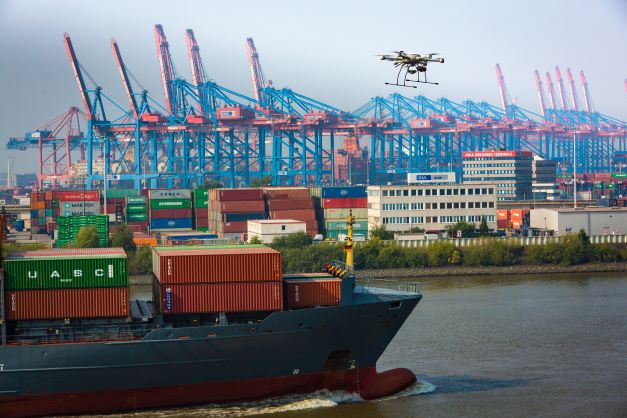Potential solution for drone collision avoidance
1st December 2021

Two leading developers of innovative drone technology, Germany-based HHLA Sky and US-based Iris Automation, have announced a partnership to increase safety when manned and unmanned aircraft share the same airspace.
By integrating their unique technologies, the companies are aiming to improve two of the most challenging current tasks in drone operations beyond visual line of sight (BVLOS): to remotely, globally and simultaneously control over 100 industrial drones from a centralised control centre while increasing local airspace safety by detecting and avoiding other unmanned or manned aircraft.
Merging HHLA Sky’s drone control centre software with Iris Automation’s ground-based aircraft detection technology Casia G opens up a whole new spectrum of use cases for industrial- and security-related drone operations worldwide. These include security surveillance tasks at ports, critical infrastructures, border control and oil and gas industry as well as (intra)logistics, surveying, and asset inspections.
HHLA Sky’s unique drone control centre was developed as the first end-to-end solution for large-scale, industrial and security drone operations beyond visual line of sight (BVLOS). The innovative IoT platform connects, and controls unmanned systems. It allows complete management, monitoring, and reporting across all aspects and tasks of 100+ industrial drones simultaneously – from only one integrated control centre that can be operated globally.
Drones connected with this IoT platform can carry out a wide range of assignments: from perimeter security (e.g. transmitting real-time video feeds) and inspections at ports, plants, and industrial sites (e.g. structured and repeatable data collection), to delivery (e.g. ship-to-shore delivery), environmental monitoring and surveying grounds and buildings. The IoT platform has cyber security built into its core and offers broad analysis and auditing features.
Iris Automation’s innovative Casia G solution is an autonomous ground-based aircraft detection technology. The computer vision system monitors aviation environments to detect, classify and – if necessary – alert UAV pilots to crewed aircraft that pose a risk to drone operations. Using Casia G, remote pilots and their teams may react to otherwise undetectable non-cooperative aircraft (those without transponders or ADS-B and therefore not broadcasting their location). Networking Casia G nodes provide unlimited coverage to protect critical infrastructure, regardless of size.
Matthias Gronstedt, CEO of research and development at HHLA Sky, said: “As our customers’ drone operations grow, safety must scale with it. The ability of Casia G to detect non-cooperative air traffic and provide essential data to the HHLA Sky system, gives us the opportunity to add yet another crucial level of safety.
“This is an important development – both for us and our customers. We are looking forward to offering a truly innovative but affordable BVLOS solution on an industrial scale. Iris Automation’s regulatory expertise and work with bodies such as the Federal Aviation Administration (FAA) also provides an important added value for us and our partnership.”
Jon Damush, CEO, Iris Automation, added: “One-to-many operations are a key enabler to realising the true economic potential of drones. Doing it safely is critical to sustainability of the ecosystem. Automatic traffic awareness supports safe, scalable, commercial operations the HHLA Sky system is designed to unlock.”
HHLA Sky and Iris Automation are planning to host a closed demonstration event to showcase the integration of both technologies in the spring of 2022. Interested parties may CLICK HERE to register for an invitation to this demo event.

